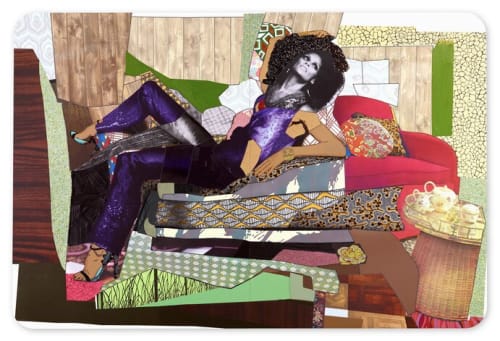Now, thanks to Denise Murrell, an art historian with a background in finance, Laure has emerged from the shadows. We find her in the company, what’s more, of dozens of other black models in modern art.
“Olympia” itself rarely leaves Paris, so it is not among the works in “Posing Modernity: The Black Model From Manet and Matisse to Today” at Columbia University’s Miriam and Ira D. Wallach Art Gallery. (It will, however, be the centerpiece of an expanded version of the show traveling to the Musée d’Orsay in March.)
However, a little-known portrait by Manet of Laure is included — it is the show’s capstone. It is joined by great works by 19th-century artists Eugène Delacroix, Frédéric Bazille, Edgar Degas, Thomas Eakins and Jean-Léon Gérôme; by 20th-century artists Henri Matisse, Romare Bearden and Norman Lewis; and by contemporary artists Lorraine O’Grady, Ellen Gallagher and Mickalene Thomas, among others.
Thomas also is the subject of a survey “I Can’t See You Without Me” at the Wexner Center for the Arts in Columbus, Ohio. It’s a perfect pendant to “Posing Modernity,” as Thomas’s work — large, lavishly decorated paintings that shimmer with rhinestones — is a kind of prolonged visual fantasia on the erotics and politics of the black female model.
The Columbus show displays more images of black models by African American artists, including Archibald Motley and Beauford Delaney, not to mention the great Romare Bearden, who was deeply engaged with both Manet and Matisse. Like Thomas, Bearden’s work is presented in both shows.
Thomas’s visually dazzling work owes much to Bearden. She, too, draws on both the hyperventilating decorative intensity of Matisse’s Nice years and Manet’s interest in the eroticized model knowingly playing a role. But Thomas’s proliferating patterns are loaded with black cultural significance, and her relationships to her reclining models is deeply personal: She depicts her mother (a former model), her female lovers and herself.
The way Thomas describes her models precisely echoes how “Olympia” is usually described — only now, it’s as much about race as gender: “The women in my work throw up a pretty formidable barrier to the tradition of fetishization of black skin. They look right back at the viewer with self-knowledge, demanding to be seen while creating the impression of seeing right through the viewer.”
For 160 years, viewers have been looking past the figure of Laure in “Olympia.” That, I predict, will no longer be possible.

